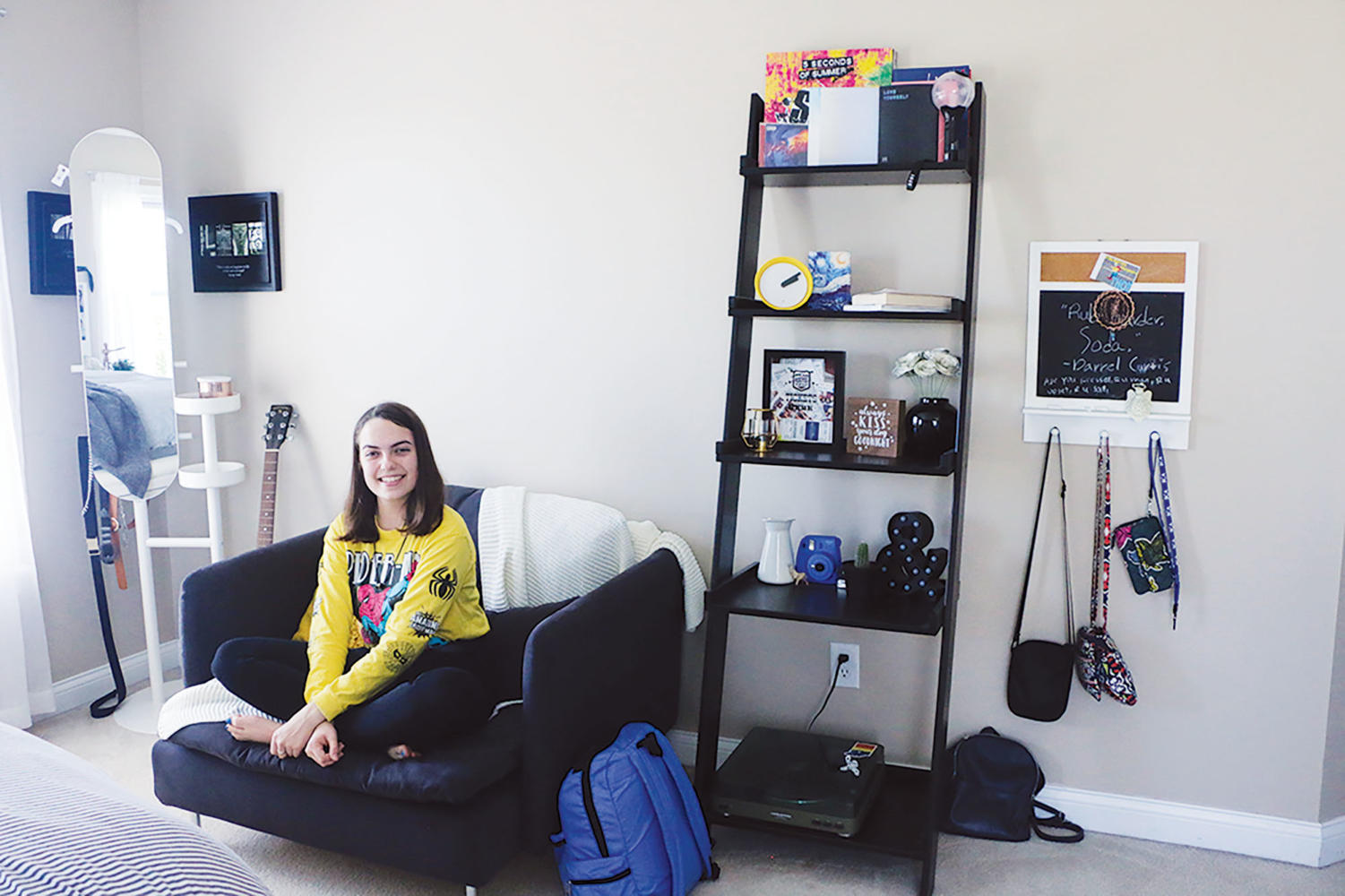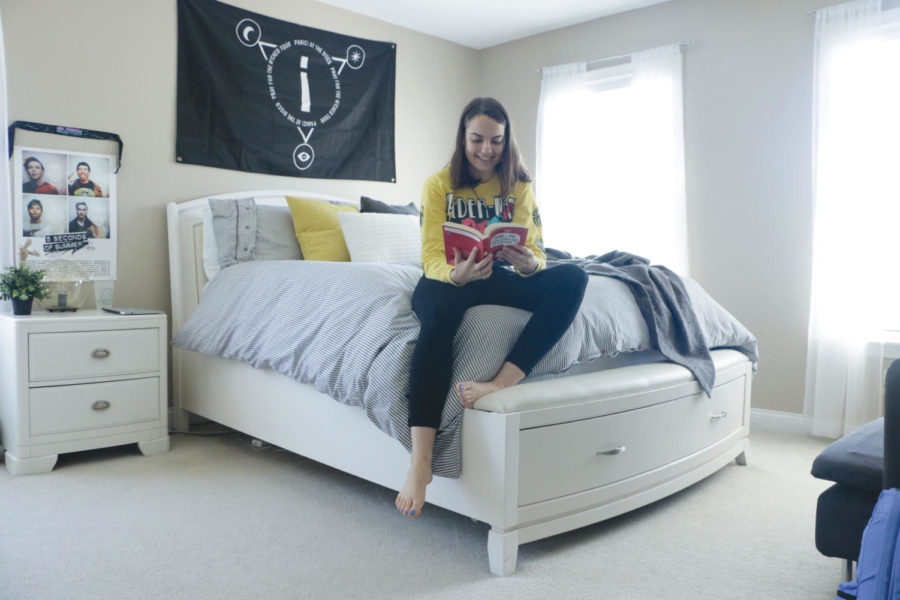Although sophomore Ashley Elmore has a couple years before she will go to college, she’s well prepared for living in a dormitory. She said she knows how to utilize her furniture in the most efficient way possible to optimize her space.

Sophomore Ashley Elmore’s room is filled with albums, band posters and musical instruments. Elmore said she thinks her room has young, bright and fresh vibes.
“(A struggle I’ve encountered) with decorating a small room is finding furniture that fits both your style and your space,” Elmore said. “(I try to) find multiple purposes for one piece of furniture, like my dresser. I put candles on top of it, but I also have clothes in it. My bed frame has drawers in it so I can put clothes in there. Finding multiple purposes for one piece of furniture is really helpful.”
Lila Torp, Intro to Housing and Interior Design teacher, has a similar viewpoint on decorating a small space, recommending that students choose furniture that has a purpose.
“If it’s a small space, then less is more,” Torp said. “Pick the (furniture) pieces very carefully and make sure they are functional…You can get a number of functional storage pieces that will double as seats and all sorts of things, so choose storage that is going to fit your needs and that’s going to fit into the space.”
Senior Sophia Marbach said sharing a small space with someone new will be one of the main difficulties when moving into college dorms this summer, rather than working with the space around her.
“I will need to share my space with somebody else, which I’m not used to,” Marbach said. “I’ve shared a room with my sister, but that’s somebody I’ve known my entire life. This will be a new person that I’ve never roomed with before, so (it might be difficult) to find a common ground on how to decorate and coming (up) with a routine and developing a new relationship and being able to cohabitate.”

Sophomore Ashley Elmore’s sits on the loveseat in her room. Elmore said she thinks different elements of her room, such as her mirror and loveseat, are interesting pieces that add to the aesthetic of her room.
Torp recommended that students choose decorations carefully as a way to help work with roommates and their decisions.
“If you want to make a small space look bigger, then you want light colors, and then use a pop of color or a bright color as accent pieces as opposed to lots of bright colors,” Torp said. “In most cases, you’re sharing (the room) with at least one other person, so if you tend to go with lights and neutrals, then whatever they bring into the other half of the room is going to blend better.”

































![AI in films like "The Brutalist" is convenient, but shouldn’t take priority [opinion]](https://hilite.org/wp-content/uploads/2025/02/catherine-cover-1200x471.jpg)









































![Review: “The Immortal Soul Salvage Yard:” A criminally underrated poetry collection [MUSE]](https://hilite.org/wp-content/uploads/2025/03/71cju6TvqmL._AC_UF10001000_QL80_.jpg)
![Review: "Dog Man" is Unapologetically Chaotic [MUSE]](https://hilite.org/wp-content/uploads/2025/03/dogman-1200x700.jpg)
![Review: "Ne Zha 2": The WeChat family reunion I didn’t know I needed [MUSE]](https://hilite.org/wp-content/uploads/2025/03/unnamed-4.png)
![Review in Print: Maripaz Villar brings a delightfully unique style to the world of WEBTOON [MUSE]](https://hilite.org/wp-content/uploads/2023/12/maripazcover-1200x960.jpg)
![Review: “The Sword of Kaigen” is a masterpiece [MUSE]](https://hilite.org/wp-content/uploads/2023/11/Screenshot-2023-11-26-201051.png)
![Review: Gateron Oil Kings, great linear switches, okay price [MUSE]](https://hilite.org/wp-content/uploads/2023/11/Screenshot-2023-11-26-200553.png)
![Review: “A Haunting in Venice” is a significant improvement from other Agatha Christie adaptations [MUSE]](https://hilite.org/wp-content/uploads/2023/11/e7ee2938a6d422669771bce6d8088521.jpg)
![Review: A Thanksgiving story from elementary school, still just as interesting [MUSE]](https://hilite.org/wp-content/uploads/2023/11/Screenshot-2023-11-26-195514-987x1200.png)
![Review: "When I Fly Towards You", cute, uplifting youth drama [MUSE]](https://hilite.org/wp-content/uploads/2023/09/When-I-Fly-Towards-You-Chinese-drama.png)
![Postcards from Muse: Hawaii Travel Diary [MUSE]](https://hilite.org/wp-content/uploads/2023/09/My-project-1-1200x1200.jpg)
![Review: "Ladybug & Cat Noir: The Movie," departure from original show [MUSE]](https://hilite.org/wp-content/uploads/2023/09/Ladybug__Cat_Noir_-_The_Movie_poster.jpg)
![Review in Print: "Hidden Love" is the cute, uplifting drama everyone needs [MUSE]](https://hilite.org/wp-content/uploads/2023/09/hiddenlovecover-e1693597208225-1030x1200.png)
![Review in Print: "Heartstopper" is the heartwarming queer romance we all need [MUSE]](https://hilite.org/wp-content/uploads/2023/08/museheartstoppercover-1200x654.png)




